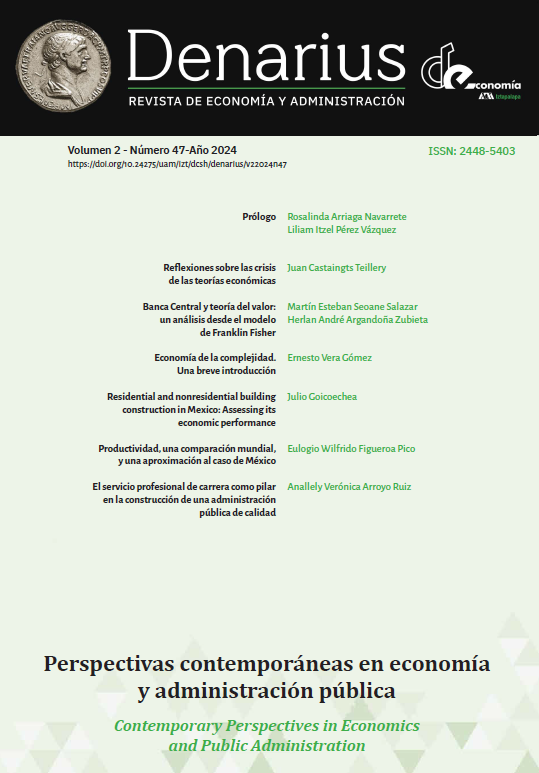Residential and nonresidential building construction in Mexico:
Assessing its economic performance
Abstract
Building industry continues to be an outstanding activity in Mexico. This paper analyzes its construction performance considering basic economic elements. For statistical purposes, this activity is classified in residential and non-residential premises. The period under analysis is from 2003 to 2022 with an annual frequency. Gross output of residential building construction growth has grown 1.9%, below the parallel nonresidential sector (2.6%). The expansion of gross output rest of the economy has been 2.5%. In the aftermath of the Great Recession in the United States, the number of Mexican job posts in building construction has been declining. Unlike nonresidential building construction, the coefficient of employment with respect to intermediate consumption is elastic regarding residential building construction. Hence, this last sector exposes a labor intensive profile. Compensation of labor continues to depict a declining share of gross value added as from the second decade of this century. A rise of this last variable in relation to gross value added itself, brings about a negative coefficient in product wages with one year lag. However, product wages rose higher than real wages in residential and nonresidential building construction. This wedge has operated in the benefit of labor as a final consumer.
Downloads
References
Abdih, Y. and Danninger, S. (2017). What explains the decline of the U.S. labor share of income? An analysis of state and industry data. Working Paper 17(167). <https://www.imf.org/en/Publications/WP/Issues/2017/07/24/What-Explains-the-Decline-of-the-U-S-45086>.
Ashenfelter, O.C., Farber H. and Ransom, M.R. (2010). Modern models of monopsony in labor markets: A brief survey. IZA Discussion Paper No. 4915. <https://docs.iza.org/dp4915.pdf>
Banco de México. (1969). Cuentas nacionales y acervos de capital: consolidadas y por tipo de actividad económica, 1950-67. Mexico: Banco de México, Departamento de Estudios Económicos.
Banco de México. (2013). Informe trimestral, octubre–diciembre 2013. Mexico: Banco de México. <https://www.banxico.org.mx/publicaciones-y-prensa/informes-anuales/%7BEA277C6D-E723-7F50-4127-05EA6F2B6575%7D.pdf>
Banco de México. (2014). Informe trimestral, julio-septiembre. México: Banco de México. <https://www.banxico.org.mx/publicaciones-y-prensa/informes-trimestrales/%7B897BB8E2-3D80-DF01-7B8C-F7D20A568BC3%7D.pdf>
Bhaskar, V., Manning, A. and To, T. (2002). Oligopsony and monopsonistic competition in labor markets. Journal of Economic Perspectives, 16(2), 155-174. doi: 10.1257/0895330027300.
Boal, W.M. and Ransom, R. (1997). Monopsony in the labor market. Journal of Economic Literature 35(1), 86-112. doi: 10.1257/aer.20200025.
Bosworth, B. and Perry, G.L. (1994). Productivity and wages: Is there a puzzle? Brookings Papers on Economic Activity, I, 317-344. <https://www.brookings.edu/wp-content/uploads/1994/01/1994a_bpea_bosworth_perry_shapiro.pdf>.
Cofece. (2015). Criterios técnicos para el cálculo y aplicación de un índice cuantitativo para medir la concentración del mercado. Mexico: Comisión Federal de Competencia Económica. <https://www.cofece.mx/wp-content/uploads/2017/11/criterios_tecnicos_para_medir_concentracin_del_mercado.pf>.
Coneval. (2023). Documento de análisis sobre la medición multidimensional de la pobreza, 2022. August. Mexico: Consejo Nacional de Evaluación de la Política de Desarrollo Social. <https://www.coneval.org.mx/Medicion/MP/Documents/MMP_2022/Documento_de_analisis_sobre_la_medicion_multidimensional_de_la_pobreza_2022.pdf>.
Colander, D. (2014). Gross output: a new revolutionary way to confuse students about measuring the economy. Eastern Economic Journal 40, 451-455. doi: 10.1057/eej.2014.39.
FAO. (1996). A system of economic accounts for food and agriculture. rome: food and agriculture organization. <https://www.fao.org/3/W0010E/W0010E00.htm#Contents>.
Hall, R.E. (1991). Labor demand, labor supply and employment volatility. NBER Macroeconomics Annual, 6, 17-47 Chicago: University of Chicago Press. <https://www.jstor.org/stable/3585045>.
Hammermesh, D.S. (1993). Labor demand. Princeton: Princeton University Press.
Hicks, J. R. ([1932] 1963). The theory of wages. London: Palgrave Macmillan.
Hirsch, B., Elke, J.J. and Schnabel, C. (2018). Do employers have more monopsony power in slack labor markets? ILR Review 71(3), 676-704. <https://www.jstor.org/stable/26956410>.
Hulten, C.R. (1992). Accounting for the wealth of nations: the net versus gross output controversy and its ramifications. Scandinavian Journal of Economics, Supplement. Proceedings of a Symposium on Productivity Concepts and Measurement Problems: Welfare, Quality and Productivity in the Service Industries, 94, S9-S24. doi: 10.2307/3440242.
Ibarra, C.A., and Ros, J. (2019). Why are workers getting a smaller share of the cake in Mexico? Blog. UNU Wider. Helsinki: United Nations University. <https://www.wider.unu.edu/publication/why-are-workers-getting-smaller-share-cake-mexico>
Inegi (undated). Banco de Información Económica. Aguascalientes: Instituto Nacional de Estadística, Geografía e Informática <https://www.inegi.org.mx/app/indicadores/?tm=0>
Jorgenson, D.W., Landefeld, J.S. and Nordhaus, W.D. (2006). New architecture for the US national accounts. Chicago: NBER and University of Chicago Press.
Kehoe, P., Midrigan, V., Pastorino, E. (2016). Debt constraints and the labor wedge. American Economic Association Papers and Proceedings of the 128 Annual Meeting, 106(5), 548-553. <https://www.jstor.org/stable/43861080>.
Manning, A. (2005). Monopsony in motion: imperfect competition in labor markets. New Jersey: Princeton University Press.
Manyika, J., Mischke, J., Bughin, J., Woetzel, L., Krishnan, M. and Cudre, S. (2019). A new look at the declining labor share of income in the United States. Discussion Paper McKinsey Global Institute. <https://www.mckinsey.com/~/media/mckinsey/featured%20insights/employment%20and%20growth/a%20new%20look%20at%20the%20declining%20labor%20share%20of%20income%20in%20the%20united%20states/mgi-a-new-look-at-the-declining-labor-share-of-income-in-the-united-states.pdf>.
Marshall, A. (1890). Principles of economics, 8th edition. London: Palgrave Macmillan.
MacKinnon, J. Haug, A.A. and Michelis, L. (1999). Numerical Distribution Functions of Likelihood Ratio Tests for Cointegration. Journal of Applied Econometrics, 14, 563-577.<http://dx.doi.org/10.1002/(SICI)1099-1255(199909/10)14:5<563::AID-JAE530>3.0.CO;2-R>
Mortensen, D.T. (1970). A theory of wage and employment dynamics (in Phelps, E.D., editor) Microeconomic foundations of employment and inflation theory. New York: Norton.
Munley, F. (1981). Wages, salaries, and the profit share: a reassessment of the evidence. Cambridge Journal of Economics, 5(2), 159-173. doi: 10.1093/oxfordjournals.cje.a035477.
NAICM (2016) Nuevo Aeropuerto Internacional de la Ciudad de México. Programa Estratégico/Institucional. Mexico: Grupo Aeroportuario de la Ciudad de México y Secretaría de Comunicaciones y Transportes <https://www.gacm.gob.mx/doc/pdf/naicm-interiores-vf.pdf>
NAICS (2022) North American Industry Classification System. Washington: Excecutive Office of the President of the United States <https://www.census.gov/naics/reference_files_tools/2022_NAICS_Manual.pdf>
Pigou, A.C. (1938). The economics of welfare. London: Macmillan.
NBER. (undated). Business cycle dating. Boston: National Bureau of Economic Research. <https://www.nber.org/research/business-cycle-dating>.
Oseguera Sauri, A.C. (2022). Concentración en el mercado laboral y su relación con los salarios en México. Estudios Económicos 37(1), 45-102. doi: 10.24201/ee.v37i1.426.
Real Estate Market. (2014). Industria de la construcción profundizó contracción en 2013. Mexico: Real Estate Market. <https://realestatemarket.com.mx/noticias/infraestructura-y-construccion/13129-industria-de-la-construccion-profundizo-contraccion-en-2013.>
Ricardo, D. ([1821] 2001). On the principles of political economy and taxation. Kitchener: Batoche Books. <https://socialsciences.mcmaster.ca/econ/ugcm/3ll3/ricardo/Principles.pdf>.
Robinson, J. (1923). The economics of imperfect competition. London: Macmillan.
Skousen, M. (1990). The structure of production. New York: New York University Press.
Skousen, M. (2017). Blocking progress in Austrian economics: A rejoinder. Procesos de Mercado. Revista Europea de Economía Política, 14(2), 143-172. doi: 10.52195/pm.v17i1.14.
Stockhammer, E. (2012). Why have wage shares fallen? A panel analysis of the determinants of functional income distribution. ILO Conditions of Work and Employment Research Series No. 35, Geneva: International Labor Organization. <https://www.ilo.org/wcmsp5/groups/public/---ed_protect/---protrav/---travail/documents/publication/wcms_202352.pdf>.
World Bank. (undated). Gini Index-Mexico. Washington: The World Bank. <https://data.worldbank.org/indicator/SI.POV.GINI?locations=MX>.
Shimer, R. (2009). Convergence in macroeconomics: the labor wedge. American Economic Journal. Macroeconomics, 1(1), 280-297. doi: 10.1257/mac. 1.1.280.
SNA. (2008). System of National Accounts. New York: United Nations et al. <https://unstats.un.org/unsd/nationalaccount/docs/SNA2008.pdf>.
Copyright (c) 2024 Denarius

This work is licensed under a Creative Commons Attribution-NonCommercial-ShareAlike 4.0 International License.














